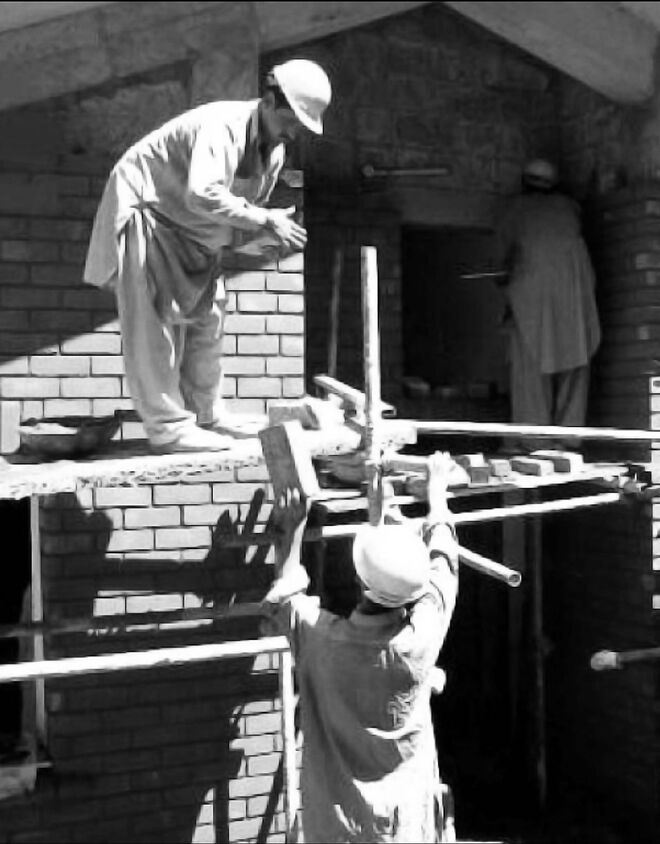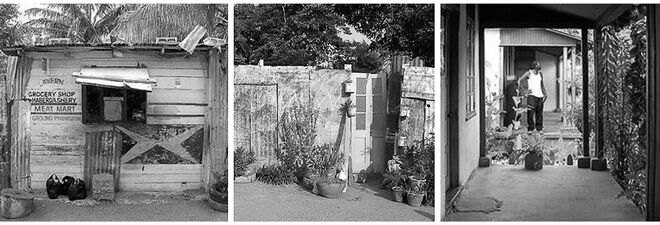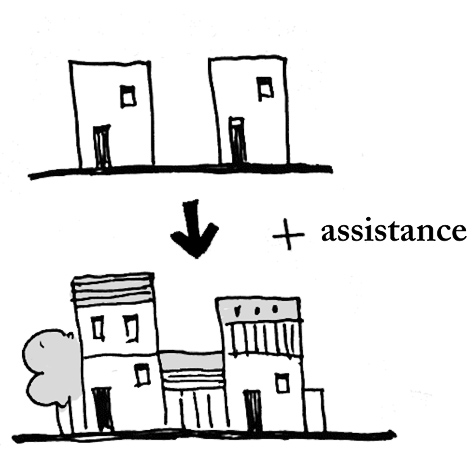14.4. Incremental Self-Build
Aus Pattern Language Wiki
(Weitergeleitet von .../Incremental Self-Build)
In Slum Upgrade and other forms of Urban Regeneration, it is often necessary as well as beneficial to harness the capacity of people to build for themselves.
Problem-statement: Often residents of informal settlements do not have the capability to build all at once, or with the services of builders or contractors. Nor do they have the capability to buy existing homes.
Discussion: The simplest way to handle this challenge is a practice that goes on around the world every day: people build for themselves. There are many advantages to this practice. People know best what their own needs are, and know when they are able to devote the time and expense to construction. They also tend to produce more unique and creative results.
Of course, there are drawbacks too. One of the most important is simply that individual residents may not have the skill to produce a good quality building that is attractive, functional, or perhaps even safe. They may run afoul of many regulations designed to protect the life and safety of residents and visitors, as well as the interests of neighbors and the public in a supportive contribution to the public realm.
Yet there are many examples of self-build structures that are very beautiful and successful. What is needed is guidance, in the form of design resources, assistance, instruction, training and the like. This can be provided at the local level by those who today may be trying to stop self-build schemes: building inspectors, plans examiners, and other building authorities.
Therefore:
Provide resources for people to self-build their own homes and other buildings incrementally, as they are able to afford the construction and have the time.
Provide for the skills needed in the Neighborhood Planning Center, including pattern language resources and Entitlement Streamlining…
¹ A further discussion of this topic is in Bredenoord, J., & van Lindert, P. (2010). Pro-poor housing policies: Rethinking the potential of assisted self-help housing. Habitat International, 34(3), 278-287.
Mehaffy, M. et al. (2020). INCREMENTAL SELF-BUILD (pattern). In A New Pattern Language for Growing Regions. The Dalles: Sustasis Press. Available at https://pattern-language.wiki/.../Incremental_Self-Build
SECTION I:
PATTERNS OF SCALE
1. REGIONAL PATTERNS
Define the large-scale spatial organization…
1.4. 400M THROUGH STREET NETWORK
2. URBAN PATTERNS
Establish essential urban characteristics…
3. STREET PATTERNS
Identify and allocate street types…
4. NEIGHBORHOOD PATTERNS
Define neighborhood-scale elements…
5. SPECIAL USE PATTERNS
Integrate unique urban elements with care…
6. PUBLIC SPACE PATTERNS
Establish the character of the crucial public realm…
7. BLOCK AND PLOT PATTERNS
Lay out the detailed structure of property lines…
8. STREETSCAPE PATTERNS
Configure the street as a welcoming place…
9. BUILDING PATTERNS
Lay out appropriate urban buildings…
10. BUILDING EDGE PATTERNS
Create interior and exterior connectivity…
10.1. INDOOR-OUTDOOR AMBIGUITY
SECTION II:
PATTERNS OF MULTIPLE SCALE
11. GEOMETRIC PATTERNS
Build in coherent geometries at all scales…
11.2. SMALL GROUPS OF ELEMENTS
12. AFFORDANCE PATTERNS
Build in user capacity to shape the environment…
13. RETROFIT PATTERNS
Revitalize and improve existing urban assets …
14. INFORMAL GROWTH PATTERNS
Accommodate “bottom-up” urban growth…
15. CONSTRUCTION PATTERNS
Use the building process to enrich the result…
SECTION III:
PATTERNS OF PROCESS
16. IMPLEMENTATION TOOL PATTERNS
Use tools to achieve successful results…
16.2. ENTITLEMENT STREAMLINING
16.3. NEIGHBORHOOD PLANNING CENTER
17. PROJECT ECONOMICS PATTERNS
Create flows of money that support urban quality…
17.4. ECONOMIES OF PLACE AND DIFFERENTIATION
18. PLACE GOVERNANCE PATTERNS
Processes for making and managing places…
18.3. PUBLIC-PRIVATE PLACE MANAGEMENT
19. AFFORDABILITY PATTERNS
Build in affordability for all incomes…
19.1. INTEGRATED AFFORDABILITY
20. NEW TECHNOLOGY PATTERNS
Integrate new systems without damaging old ones…
20.2. RESPONSIVE TRANSPORTATION NETWORK COMPANY


